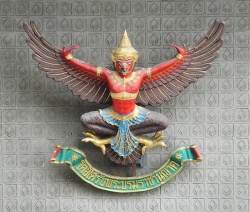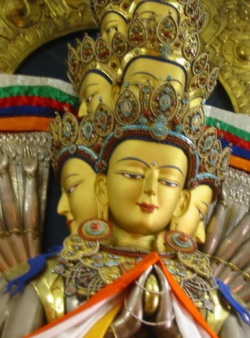Bhāva
Bhāva (Sanskrit: bhāva, 'state, condition') is a term in Jyotisha denoting a fixed zodiacal division of the sky from the perspective of an observer. It corresponds to the concept of "house" in Western astrology. A natal chart is called bhāvacakra (Sanskrit: cakra, 'wheel'.)
In almost all traditional practice, the twelve houses (bhāva) of an astrological chart have the same boundaries as the twelve signs in the chart; in other words, each sign is a house in the chart. The beginning of each house is the 0th degrees of the sign and the end is the 30th degree of the sign. What varies from chart to chart is the enumeration of these houses, i.e., which sign is the first house, which is the second, and so forth. This is determined by the position of the Lagna (the Ascendant, or the longitudinal point of the zodiac that was rising in the East at birth.) The house in which the Lagna falls is always the first house of the chart, and the other houses follow it, counter-clockwise, in the sequence of the zodiac.
Each of the twelve houses signifies a region of the concerns of life, and the identity of the sign of that house colors what may be expected from that life.
More than one system to align houses with signs are recognized in Jyotisha. The most common method is described above, a method that Western astrologers call the whole sign house system; another is Sripathi, introduced by Sripati, akin to a Porphyry house system. The modern Krishnamurti Paddhati also incorporates a Placidus house system.
The principle of House Division introduced in Sripathi Bhāva System is described as follows: "In the Sripathi system the 1st house cusp is the Lagna, and the 7th house cusp is the Descendant opposite it, the 10th house cusp is at the MC (Medium Coeli or Madhya Lagna), i.e. Zenith, and the 4th house cusp is at the IC (Imum Coeli or Patala Lagna) i.e. Nadir. The four quarters divided thus should be divided into three equal parts each, and thus we find the 12 house cusps in Sripathi system. To find the Bhava Sandhis (meeting points of houses) we should divide the distance between the house cusps into halves."
The houses
The names of the 12 houses and the areas of life represented by them are:
Lagna - Nature of Native, Appearance, Health, Character, Purpose of Life, behavior, birth, limbs, head
Dhana - Wealth, Family, Domestic Comforts, Early Education, Inheritance, Speech, moveable asssets
Parakrama - Younger Brothers and Sisters, Communication (Talking, Writing, Business Documents), Intelligence, fine arts Short Journeys, "great prowess (physical and mental)," hands, arms, shoulders
Suhṛda - Mother, Emotions, Education, Home, Property and Land, Surrounding in Old Age, vehicles, the chest
Suta - Children, Lovers, Recreation Devotion, Speculation and Gambling,] the belly, accumulated karma
Ripu/Roga - Diseases,] Maternal uncle and aunt, Litigation, Servants, Mental Worries, Enemies, Foreigners, small intestine,
Kāma - Spouse, Business Partner, Death, Respect, passion, groin
Mṛtyu - Death & Longevity, Obstacles, Suffering, Sexual organs and sexual attractiveness, Occult, Dowry, Inheritance, Imprisonment, Excretory organs, accidents
Bhāgya - Father, Luck, Higher learning, Philosophy & Religion, Mentor or Guru, Prosperity, Travel, "deeds of virtue"
Karma - Profession, Status & fame, Power, Father, Mother-in-law, Government, Clothes,Commerce, knees
Āya - Friends, Hopes, Earnings, Club or Social Activities, Elder Brothers and Sisters, Daughter/Son-in-law, calves, shins and ankles
Vyaya - Expenses, Sleep (and convalescence), Sexual pleasures, Spirituality, Travel & Pilgrimage, Secret Enemies, Imprisonment, Hospitals, Asylums, Liberation, loss foreign residency,] feet
Classifications
In general houses are classified into four categories:
Kendra: the angular houses, that is the first, fourth, seventh and tenth houses. (kendra, from Greek κἐντρα, also describes the relationship between any houses or grahas which are about 90 degrees apart.) These are very strong houses for grahas to occupy.
Trikona: the houses forming a triangle within the chart with the first house, about 120 degrees apart from one another, that is the first, fifth and ninth. These are the most auspicious houses. (From Greek τρἰγωνα.
Dusthāna: the less fortunate houses which tend to rule unhappy areas. These houses make no clear geometric connection to the Lagna. Dusthanas include the sixth, eighth and twelfth houses.
Upachaya: "growth" or "remedial" houses, where malefic planets tend to improve, include the third, sixth, tenth and eleventh houses.
Succedent houses are called pāṇaphara (from Greek ἐπαναφοραἱ), and cadent houses are called āpoklima (Gk. ἀποκλἰματα).



